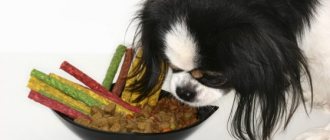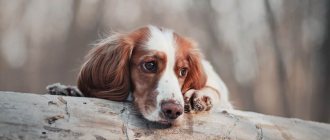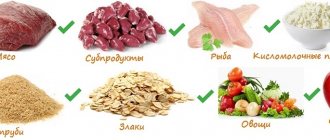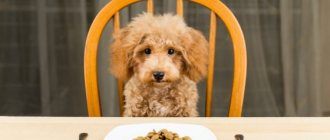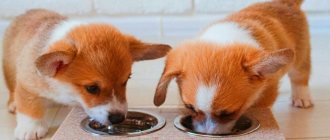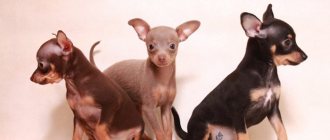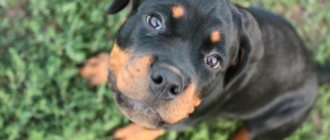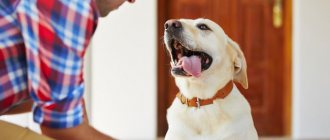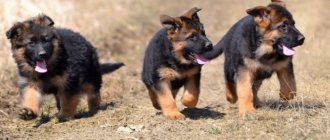Rating: 5/5 (5)
Miniature Pekingese are the ideal dog for a city apartment. These animals are compact, do not require much physical activity, are easy to train and intelligent. Dogs of this breed require careful care . The long, thick coat, eyes and ears require constant monitoring, and the delicate digestive system requires a balanced diet.
Despite a number of conditions, living with a Pekingese in the same apartment does not cause much trouble . It is important from the first days to develop rituals for caring for the dog and strictly adhere to them. Controlling the diet, daily grooming, and properly organized walks will ensure excellent health and well-being for the Pekingese.
How to care for Pekingese ears
The long ears of the Pekingese , covered with long hair, require constant attention. During daily brushing, inspect the inside of the ear. The yellowish coating that appears can be removed with a cotton swab dipped in a disinfectant solution for cleaning the ears. Do not use hydrogen peroxide; it irritates delicate skin and can cause burns.
Brown crusts in the ear canal may indicate the appearance of ear mites.
To combat it, the ears are cleaned with lotion, and then a drug is instilled that destroys the parasites. If your dog is scratching his ears or constantly shaking his head, you should visit a veterinarian.
Ready-made food - pros and cons
When talking about the nutrition of dogs or cats, we cannot fail to mention ready-to-eat foods. Their range today is wide - different forms of release (dry or wet), the presence or absence of vitamins, additional medicinal functions, and so on. You can feed an adult Pekingese with both homemade food and ready-made food. This feeding option has one significant advantage - the needs of a specific breed are correctly taken into account when producing food. Plus, you don't have to waste time cooking.
Speaking of Pekingese, you need to choose food for long-haired dogs taking into account individual needs. There are categories of dogs that require special nutrition, these are:
- Pregnant bitches
- Nursing Pekingese
- Older dogs
- Pets with allergies
- Puppy food (homemade food is better than feeding your Pekingese puppy store-bought food)
Giving preference to the best store-bought feeds, it is necessary to ensure a constant availability of water. Based on the opinion of Pekingese owners, this breed is extremely picky and does not eat every Pekingese food. It may happen that the Pekingese refuses to eat wet food TM Chappi, but they eat dry food TM Purina with pleasure. Experienced breeders advise feeding Pekingese with Eukanuba TM food or using Hill's. These brands are classified as premium.
If for one reason or another you decide to switch your dog to homemade food, it is better to keep in mind that this should be done gradually. On average, the transition will take about two weeks.
Pekingese coat care
The long, soft coat with a thick undercoat requires daily grooming . To comb, you need a metal comb with a long handle and a wire brush. To remove tangles, you will need scissors with rounded tips.
Pekingese are brushed daily. The ears, chest, fur on the sides and belly, the tail and the “skirt” underneath it are combed especially carefully. The matted areas are torn apart with your fingers and treated with a wire brush; it is better to cut off any tangles that accidentally appear. In the warm season, the Pekingese can be cut, this will make caring for the coat easier. Most often, the dog is cut like a lion; any groomer can handle the procedure.
The Pekingese's face should be wiped daily with a damp cloth, carefully treating the skin folds . The lower part of the muzzle should also be wiped after eating, especially if the dog eats natural food.
Pekingese require periodic bathing . You should not wash your pet too often; hard water can disrupt the lipid balance of the coat. The dog is bathed if it gets dirty during a walk, as well as before a show or grooming. For washing, you need to use shampoo designed for long-haired dogs. Pekingese are bathed in a bathtub or shower tray; after washing, the coat should be thoroughly rinsed, dried with a terry towel and dried with a hairdryer.
From time to time, the Pekingese can be cleaned with a special dry shampoo, and then combed thoroughly. In the warm season, it is recommended to wash a dog traveling outside the city with shampoo that protects against parasites .
Basic rules regarding dog health
Caring for a Pekingese involves regular brushing; you also need to constantly monitor the condition of the coat, ears, skin, and trim the claws.
- Eyes. It is important to keep them clean. If a foreign object is found, it must be removed using a cotton pad or swab. There should be drops in stock to eliminate the inflammatory process in the organs of vision or to get rid of acidification.
- Wool. The dog should be brushed frequently with a special massage comb. From early childhood, the animal must get used to such manipulations. Water procedures occur rarely, using special shampoos. To keep the coat and skin clean, in between baths you should wear a special overall for your dog during walks in winter or light clothing in summer.
- It is also necessary to regularly examine the oral cavity. The teeth should be white, smooth, and the gums should be pink in color, without ulcers or other problems. The animal's teeth should be brushed using special means. The inspection must be systematic to prevent the development of any troubles.
- Ears must be washed with a special solution. If you experience any discharge from your ears, be sure to visit a veterinarian. The skin fold above the bridge of the nose is wiped with a soft, dry piece of cloth.
- Nails should be trimmed using special scissors. Pekingese rarely need to trim their nails, since they are inactive by nature and their claws wear down slowly. You should not cut it short so as not to hurt the Pekingese. Thanks to this, in the future the animal will not resist during the next claw trimming procedure.
Such an animal can become a good friend. But when choosing a pet, you should consider all the positive and negative aspects. Raising a pet is not difficult. But it is not recommended to purchase such an animal if there are small children in the house, as aggression may occur.
Pekingese claw care
The Pekingese does not like to run too much, so the claws on its paws hardly wear down. To prevent overgrown plates from disturbing the animal, you should regularly trim the nails with special clippers for small breed dogs. Do not use regular nail clippers; they split the nails, which causes discomfort for the dog.
Claws are trimmed as they grow. Only the sharp tip is removed; you cannot cut off too much, so as not to damage the living part of the claw. If you accidentally cut off excess, disinfect the wound with a solution of hydrogen peroxide.
nails are trimmed by 1-2 mm every month.
What to feed a Pekingese puppy
| Puppy age (months) | Number of feedings per day | Menu |
| Up to a month | From the first week of life - every 2 hours. |
|
| 1-2 | 6 |
|
| 2-3 | 5 |
|
| 3-6 | 3 |
|
| 6-8 | 2-3 |
|
| From 8 | 2 |
|
Watch a short video of how a two-month-old girl eats!
Vitamins and vaccinations for Pekingese
A purebred puppy receives its first vaccinations from the breeder. Appropriate marks are placed on the puppy card. Pekingese require vaccinations against canine distemper, viral hepatitis, enteritis, leptospirosis and adenovirus infection. At 12 months, a mandatory revaccination is carried out, at the same time the dog receives a rabies vaccination, which must be given annually. The animal should be vaccinated with a high-quality vaccine, making sure to mark it on the medical card.
If the Pekingese eats a balanced industrial food, there is no need to give additional vitamins; everything necessary is already included in the diet. Pets receiving natural nutrition can be given a complex supplement for decorative dogs , which improves the appearance of the coat. It contains B vitamins and valuable microelements.
What to feed an adult Pekingese
When feeding an adult dog, you should consider:
- Serving size should be adjusted depending on activity and weight;
- if the dog leaves food, you should reduce the portion, if it rattles the bowl, increase it;
- in summer, reduce the amount of protein and portion, increasing the amount of fiber; in winter, vice versa;
- Pekingese are gourmets, so their diet should be varied;
- The serving size of the dry product is indicated on the packaging and is a recommendation.
Pekingese clothes
During the cold season, the Pekingese needs additional protection during walks. The most convenient option for winter is a warm jumpsuit made of soft, non-rusting fabric with a padding polyester lining. Such clothing does not restrict the dog’s movement and warms its fragile body well.
In wet weather, a waterproof overall with a hood, under which you can hide your long ears, will come in handy. If you can’t find suitable clothes in the store, you can have them made to order.
In the summer , Pekingese walking outdoors may need a special mesh overall made of lightweight fabric. Such clothing will protect the silky coat from debris, and the dog itself will be protected from ticks. Complete your summer outfit with a flea collar.
A very useful accessory is shoes .
To prevent paw pads from suffering from the sand-salt mixture, protect them with soft boots. Please note that some dogs categorically refuse to wear shoes; in this case, the paw pads will have to be protected with a special cream.
The main components of the Pekingese diet
As mentioned earlier, representatives of the Pekingese breed should receive a varied diet. For this reason, it is worthwhile to dwell in more detail on each food group when answering the question of what to feed your Pekingese at home.
Meat, fish and offal
In order to keep your pet in excellent physical shape, you should give preference only to lean varieties of meat. It can be:
- Beef (veal)
- rabbit
- chicken
- turkey
- Chicken giblets, however, only as an addition to a meat dish
Dog owners often wonder if it's okay to give dogs a lot of raw meat? Yes, you can feed dogs, including Pekingese, raw meat. However, you can only do this if you are confident in its freshness and quality. Otherwise, it is recommended to pour boiling water over the meat product or simply boil it.
Several times a week, meat can be replaced with fish. The requirements for fish are the same as for meat; it must be lean and cleaned of all bones. Judging by the reviews of Pekingese owners, dogs eagerly eat horse mackerel and mackerel, especially since such fish meets the requirements described above.
Important: Do not cut meat and fish finely; the dog must crush large pieces itself, thereby developing the jaws. When choosing fish, it is recommended to avoid pollock. This fish contains a mineral responsible for binding iron, which can affect the health of the Pekingese.
Porridge in the Pekingese diet
We can say unequivocally that Pekingese eagerly eat cereal porridge. There are no special restrictions or recommendations, so in this matter you can be guided by your pet’s taste preferences. The choice of cereals is wide: buckwheat, rice, rolled oats, barley, millet and so on. The only nuance worth mentioning is that the porridge must be cooked, that is, not instant. Try not to overcook the porridge so that it does not resemble jelly in consistency; Pekingese do not like this.
Vegetables and fruits on the menu
Despite the usefulness of vegetables, not all types are eaten by Pekingese. The most acceptable ones include the following:
- Cauliflower
- Broccoli
- Zucchini
- Buryak
- Carrots (eaten with great pleasure)
- Greenery
All of the above vegetables can be included in the Pekingese diet, both raw and boiled.
As for fruits, they should not become the pet’s main diet. It is recommended to use them as a treat. From the huge assortment of fruit ones, you should give preference to the most common types, avoiding the exotic. Pekingese enjoy eating apples, apricots and peaches.
Milk and eggs
Dairy products are a storehouse of protein, which dogs need so much, especially during periods of active growth. It is extremely important for your little Pekingese puppy to get enough calcium. To do this, it is necessary to periodically give the dog calcined cottage cheese. You can prepare it correctly with your own hands at home. To do this, you will need 1 liter of cow's milk and 2-4 tablespoons of calcium chloride (can be purchased at the pharmacy). The cooking recipe includes the following steps:
- You need to bring the milk to a boil
- Add calcium chloride, stir
- After cooling, strain the milk through cheesecloth.
In addition, the Pekingese should be given regular milk (up to 2.5% fat), cottage cheese, kefir and hard cheese (no more than 100 g per week).
How many eggs can a Pekingese eat? You can give eggs to your Pekingese, but only the yolk and always boiled.
Pekingese toys
Pekingese are independent and are quite capable of entertaining themselves in your absence. To prevent your dog from getting bored, buy him special toys. Pekingese love balls and various figures made of durable latex that can be chewed and rolled. Toys should not be too big or heavy, otherwise the dog will lose interest in them.
Your pet will also enjoy soft toys made of fabric and faux fur . Make sure that there are no small parts on them that the Pekingese could bite off and swallow.
Briefly about the main thing
- Pekingese do not feel full and are prone to obesity;
- When feeding dogs, routine is important;
- Mixed types and sudden changes in products are not allowed;
- The Pekingese's diet is revised in connection with the onset of a certain age or condition.
What do you feed your Pekingese? Tell us about the secrets of cooking food for your pet in the comments, it is very important and interesting.
The Pekingese is a dog that is one of the oldest breeds. How to choose decent food for an animal that acted as a companion to Chinese nobles, princes, and even emperors for more than 2000 years? Based on numerous studies, a special scheme and menu have been developed, which we will discuss further.
The content of the article:
Safety of Pekingese in an apartment and with children
To prevent your dog from harming himself, remove small objects, plastic bags, and cords from office equipment from the floor. Hide household chemicals and products not intended for dogs in cabinets.
Explain to young children that the dog should not be touched or hurt . An unbalanced Pekingese can bite the offender very painfully. When leaving home, isolate your pet in one of the rooms, not forgetting to leave him a litter tray, a bowl of water and toys.
Life and development
For a dog to have a comfortable life, it is not recommended to walk in splendid isolation; the dog should communicate and play with other relatives. If the dog is often alone at home, then try to pay attention to it, because it is so happy with you.
Do not forget that the Pekingese is an active dog that requires attention, affection and, of course, games. A puppy needs toys and your companionship to maintain it.
It’s not enough to just have a dog, feed it and walk it, you need to exercise it, educate it, learn commands, trim nails, bathe it; you can also find more detailed information in articles about the Pekingese breed. Health and long, happy days of life for your pet.
Share link:
Walking the Pekingese
Pekingese are not very fond of walks. In bad weather, many dogs refuse to leave the premises. There is no need to insist; it is better to purchase a special tray for your pet, designed for small decorative dogs, supplemented with a special post. A large cat litter box is also suitable for females. The toilet container can be covered with a disposable sanitary diaper, which is changed regularly.
In good weather, your Pekingese should be walked in the morning and evening. This kind of exercise contributes to the dog’s normal development and well-being. Do not force your pet to walk and run for a long time and do not walk it in the heat; the Pekingese does not tolerate elevated temperatures .
For walks you will need a collar and a leash. Pekingese cannot wear harnesses ; they can negatively affect their appearance.
Pros and cons of the breed
The appearance of the Pekingese has changed significantly during the existence of the breed; if initially they strongly resembled the Japanese Chins, now they differ at first glance. The weight of a purebred Pekingese is from 3.2 to 5 kg - heavier individuals are considered defective. There is also a so-called pocket variety of mini Pekingese weighing no more than 2.5 kg.
A purebred dog must meet the following parameters:
- large head with a wide skull and a sharp transition to the muzzle;
- the neck is short and thick;
- the eyes are large, round, with black eyelids;
- the nose is quite large and flattened, with black pigmentation;
- the ears are shaped like hearts and hang down, covered with long hair;
- a mask on the face is not required in all cynological associations, but everyone recognizes that it decorates the dog;
- the chest is wide, powerful, with convex ribs;
- back straight;
- paws are short, strong, slightly turned to the sides;
- the tail is set high and lies on the back.
The main distinguishing feature of the Pekingese is its coat. It is thick and tough, with a dense undercoat. A luxurious mane is required on the shoulders and neck. The guard hair should be straight. Curliness is a disqualifying sign. Only mestizos are smooth-haired. The traditional color of the Pekingese is red, but the European standard allows for almost any coat color:
- sand;
- grey;
- black;
- white.
Multicolor colors are also allowed; only liver coats and albino dogs are considered discarded. Other colors do not affect the overall rating. It should be emphasized that it is not possible to predict the color of puppies - all Pekingese have genes for different colors. In addition to external characteristics, the standard provides for distinctive character traits of the imperial companions.
Character
A true purebred Pekingese can be easily distinguished from a selective breed by its character. Dogs from an unverified breeder can be hysterical, fearful or aggressive, with an unstable psyche. Purebred individuals are calm and balanced. Pekingese are the most independent and self-confident representatives of decorative breeds.
They love their owner and prefer to spend time with him, but they will never be intrusive; they will calmly wait for the person to return home without throwing tantrums. At the same time, they are mobile, active, and have excellent guard qualities. Funny lion cubs need to be accustomed to the company of strangers from childhood. If this is not done, Pekingese, who are already wary of strangers, can greet guests very aggressively.
This breed is most likely not suitable for a family with a small child. They are not as fragile as other indoor dogs, but children can still injure their pet while playing. In addition, Pekingese do not tolerate rough handling and can bite. But for older people they will be excellent affectionate companions.
While it is difficult to calculate the positive and negative aspects of half-breeds, purebred Pekingese have certain characteristics, on the basis of which one can decide whether such a breed is suitable for the owner or not.
| — | |
| Spectacular appearance | They shed a lot |
| Loyalty to the owner | The owner is jealous of other family members |
| Easy to care for | Subject to overheating |
| Good health | High risk of developing heart failure and respiratory diseases |
| Well developed guard qualities | They don't like children |
If you are attracted by the advantages and are not deterred by the disadvantages of the breed, you can safely go for a puppy. The main thing is to purchase it from dog handlers who value their reputation.
Features of feeding
The Pekingese moves little, has a flattened jaw and weak fangs. These features should be taken into account when creating a diet. Prohibited foods include sweets, pickles, and bones. There should always be clean water in the bowl.
For the first month of life, the puppies are fed only by the mother. In the fifth week, the breeder begins complementary feeding. He usually uses canned meat from trusted manufacturers. You can switch to natural nutrition. It is based on cow's milk, boiled minced beef, and cottage cheese. Gradually, fruits and vegetables are introduced into the diet: apples, zucchini, carrots.
Then you can gradually change the diet in favor of natural food or feed. In the second case, you need to buy only premium pates or gravy without a strong taste or smell. During this period, Pekingese eat 4-5 times a day with equal intervals between meals.
